Related Research Articles

Lucrezia Borgia was an Italian noblewoman of the House of Borgia who was the illegitimate daughter of Pope Alexander VI and Vannozza dei Cattanei. She reigned as the governor of Spoleto, in her own right, a position usually held by Cardinals.

Francis I was King of France from 1515 until his death in 1547. He was the son of Charles, Count of Angoulême, and Louise of Savoy. He succeeded his first cousin once removed and father-in-law Louis XII, who died without a legitimate son.

Heinrich Cornelius Agrippa von Nettesheim was a German Renaissance polymath, physician, legal scholar, soldier, knight, theologian, and occult writer. Agrippa's Three Books of Occult Philosophy published in 1533 drew heavily upon Kabbalah, Hermeticism, and Neoplatonism. His book was widely influential among esotericists of the early modern period, and was condemned as heretical by the inquisitor of Cologne.

Renée of France, was Duchess of Ferrara from 31 October 1534 until 3 October 1559 by marriage to Ercole II d'Este, grandson of Pope Alexander VI. She was the younger surviving child of Louis XII of France and the duchess regnant Anne of Brittany. In her later life, she became an important supporter of the Protestant Reformation and ally of John Calvin.
Jacques Buus was a Franco-Flemish composer and organist of the Renaissance, and an early member of the Venetian School. He was one of the earliest composers of the ricercar, the predecessor to the fugue, and he was also a skilled composer of chansons.
In historiography, querelle des femmes, indicates an early-modern debate on the nature of women. This literary genre developed in Italian and French early humanist circles and was led by numerous women scholars, who wrote in Latin and vernacular to counter dominant misogynistic literature.

Alfonso d'Este was Duke of Ferrara from 1504 to 1534, during the time of the War of the League of Cambrai.
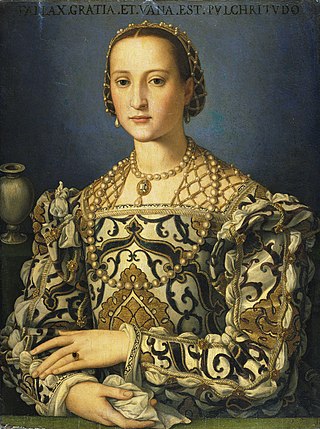
Eleanor of Toledo was a Spanish noblewoman who became Grand Duchess of Florence as the first wife of Cosimo I de' Medici. A keen businesswoman, she financed many of her husband's political campaigns and important buildings like the Pitti Palace. She ruled as regent of Florence during his frequent absences: Eleanor ruled during Cosimo's military campaigns in Genoa in 1541 and 1543, his illness from 1544 to 1545, and again at times during the war for the conquest of Siena (1551–1554). She founded many Jesuit churches. She is credited with being the first modern first lady or consort.

Arete of Cyrene was a Cyrenaic philosopher who lived in Cyrene, Libya. She was the daughter of Aristippus of Cyrene.

The concerto delle donne was an ensemble of professional female singers of late Renaissance music in Italy. The term usually refers to the first and most influential group in Ferrara, which existed between 1580 and 1597. Renowned for their technical and artistic virtuosity, the Ferrarese group's core members were the sopranos Laura Peverara, Livia d'Arco and Anna Guarini.

Margherita Barbara Gonzaga, was an Italian noblewoman, Duchess consort of Ferrara, Modena and Reggio between 1579 and 1597 by marriage to Alfonso II d'Este, Duke of Ferrara, Modena and Reggio. She was a significant cultural patron in Ferrara and Modena.

Bartolomeo Sacchi, known as il Platina after his birthplace of Piadena, was an Italian Renaissance humanist writer and gastronomist, author of what is considered the first printed cookbook.
Protofeminism is a concept that anticipates modern feminism in eras when the feminist concept as such was still unknown. This refers particularly to times before the 20th century, although the precise usage is disputed, as 18th-century feminism and 19th-century feminism are often subsumed into "feminism". The usefulness of the term protofeminist has been questioned by some modern scholars, as has the term postfeminist.
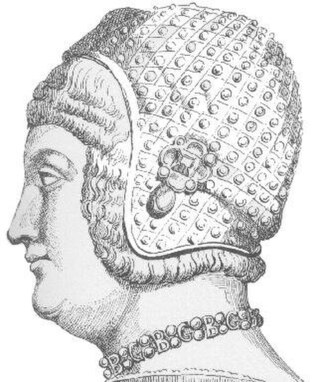
Bona of Savoy, Duchess of Milan was Duchess of Milan as the second spouse of Galeazzo Maria Sforza, Duke of Milan. She served as regent of Milan during the minority of her son 1476–1481.

Lucrezia de' Medici was a member of the House of Medici and by marriage Duchess consort of Ferrara, Modena and Reggio from 1558 to 1561.
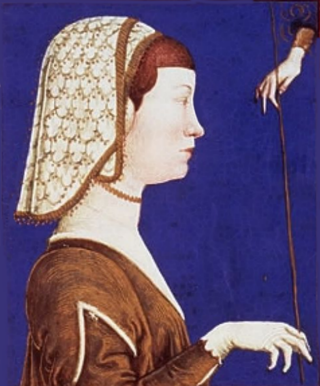
Eleanor of Naples was Duchess of Ferrara by marriage to Ercole I d'Este. She was the first duchess of Ferrara, and mother of many famous Renaissance figures. She was a well known political figure, and served as regent of Ferrara during the absence of her spouse.
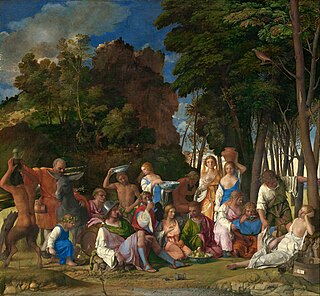
The Feast of the Gods is an oil painting by the Italian Renaissance master Giovanni Bellini, with substantial additions in stages to the left and center landscape by Dosso Dossi and Titian. It is one of the few mythological pictures by the Venetian artist. Completed in 1514, it was his last major work. It is now in the National Gallery of Art in Washington D.C., which calls it "one of the greatest Renaissance paintings in the United States".

Timoclea or Timocleia of Thebes is a woman whose story is told by Plutarch in his Life of Alexander, and at greater length in his Mulierum virtutes. According to Plutarch's biography of Alexander the Great, when his forces took Thebes during Alexander's Balkan campaign of 335 BC, Thracian forces pillaged the city, and a Thracian captain raped Timocleia. After raping her, the captain asked if she knew of any hidden money. She told him that she did, and led him into her garden, and told him there was money hidden in her well. When the Thracian captain stooped to look into the well, Timocleia pushed him down into it, and then hurled heavy stones down until the captain died.
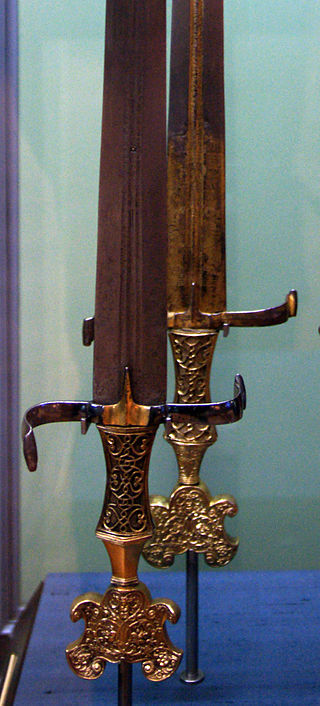
Ercole dei Fedeli was an Italian goldsmith and master sword engraver. His name has also been recorded as Ercole da Ferrara, da Sesso, dei Fidelis, de Fedeli or de Fedelis.
Michelle de Saubonne, Madame de Soubise (1485–1549) was a French courtier who served as lady-in-waiting to Anne of Brittany, as the Governess of the Children of France beginning in 1499, and as the governess for the children of Ercole II d'Este, Duke of Ferrara. She and Anne became best friends and, as she was dying, she asked Michelle de Saubon to be a mother and guardian for her daughter Renée, Duchess of Ferrara, from 1528 to 1536. Like her mother, Renée had a close relationship with Michelle, both of whom had become Protestants. Renée's husband, Ercole II, was a Catholic and he resented having many French Protestants, also known as Huguenots in his court and diverting his wife's attention away from Catholicism.
References
- ↑ "Bartolomeo Goggio". Querelle. Retrieved 20 January 2019.
- ↑ Konrad Eisenbichler (2017). The Cultural World of Eleonora di Toledo: Duchess of Florence and Siena. Taylor & Francis. pp. 126–. ISBN 978-1-351-54517-4 – via Google Books.
- 1 2 Jacqueline Broad; Karen Green (2009). A History of Women's Political Thought in Europe, 1400-1700. Cambridge University Press. pp. 56–. ISBN 978-0-521-88817-2 – via Google Books.
- 1 2 Gundersheimer, Werner L. (1980). "Bartolommeo Goggio: A Feminist in Renaissance Ferrara". Renaissance Quarterly. 33 (2): 175–200. doi:10.2307/2861116. JSTOR 2861116. S2CID 163600495.